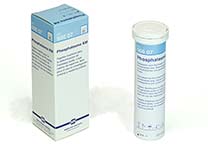Testpaper for the determination of acid phosphatase
Phosphatesmo KM is a test that is used for the presumptive idenfication of semen in stains. It is indicative for the presence of an enzyme (acid phosphatase) that is present in semen in relatively high concentrations. In the presence of acid phosphatase, the test paper develops violet stains on the white test paper.
Method of application
The carrier is normally subjected to a macroscopic examination for suspicious spots. Textiles generally assume boardlike consistency and yield a bluish, white or yellow fluorescence under a longwave UV lamp. Since this fluorescence is often difficult to see due to the fluorescence of optical brighteners from laundry detergents, the 450 nm band of the Polilight or LED light source in combination with orange goggles or 530 nm interference filters [1, 2] is a much better method.
Phosphatesmo KM offers the possibility to determine, on the spot, whether the traces found originate from spermatozoa. Take a small piece of the suspect material (a few square millimeter) and soak for about one minute in water or physiological saline solution. Remove only as many test papers as are required and reseal the container immediately after use. Expose the test paper by pulling apart the ends of the plastic tape. Do not touch the test paper zone. Place the moist test material on the test paper, which after a few seconds will show a clear, violet coloration in the presence of acid phosphase.
After the test, it can be resealed and stored as proof.
Specifity
Phosphatesmo KM is specific for acid phosphatase. Control tests with saliva, mucus or female genital secretions give negative results. The reaction is not a suitable substitute for the microscopic determination of live spermatozoa.
Storage
Avoid exposing the test papers to sunlight and moisture. Store the container below 30° C in a dry place.
References and footnotes
[1] Kobus, H.J.; Silenieks, E.; Scharnberg, J., "Improving the Effectiveness of Fluorescence for the Detection of Semen Stains on Fabrics", Journal of Forensic Sciences, Vol. 47, No. 4, July 2002, p. 819-823. DOI: 10.1520/JFS15467J
[2] Paper by Marshall, S.; Bennett, A.; Fraval, Dr. H.,"Locating Semen on Live Skin Using Visible Fluorescence" (download.)









